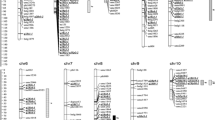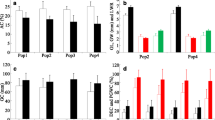Abstract
High-oil maize (Zea mays L.) has special value in animal feed and human food. Two hundred and eight-four and 265 F2:3 families developed from two crosses between one high-oil maize inbred and two normal dent maize inbreds were evaluated for grain oil and starch contents under two environments. Using composite interval mapping, 1–6 QTL for each trait were detected under each environment and in combined analysis in both populations. Only one common QTL across two environments in each population and across two populations were found for starch content. Among the detected QTL, nine digenic interactions with small effects were identified. Comparison of single-trait QTL and the results of multiple-trait QTL mapping showed that oil content might be complicatedly correlated with starch content. Although single-trait QTL with the same parental effects for both traits and oil-starch QTL were all detected at the same genetic bin 6.04 as the cloned high-oil QTL (qHO6) with no unfavorable effects on grain weight, our results did reflect the difficulty to realize simultaneous improvement on grain oil and starch contents. Of course, these results should be validated in further experiments under more environments using RILs, NILs and other permanent populations.


Similar content being viewed by others
Abbreviations
- A:
-
Additive
- ASK:
-
Alexho Single-Kernel
- BHO:
-
Beijing high oil
- CIM:
-
Composite interval mapping
- D:
-
Dominance
- IHO:
-
Illinois High Oil
- IHP:
-
Illinois High Protein
- ILO:
-
Illinois Low Oil
- ILP:
-
Illinois Low Protein
- LD:
-
Levels of dominance
- MAS:
-
Marker-assisted selection
- MIM:
-
Multiple interval mapping
- NILs:
-
Near isogenic lines
- OD:
-
Overdominance
- PD:
-
Partial dominance
- QTL:
-
Quantitative trait locus/loci
- SCA:
-
Special combining ability
- SSR:
-
Simple sequence repeat
References
Alrefai R, Berke TG, Rocheford TR (1995) Quantitative trait locus analysis of fatty acid concentrations in maize. Genome 38:894–901
Benitez JA, Gernat AG, Murillo JG, Araba M (1999) The use of high oil corn in broiler diets. Poult Sci 78:861–865
Berke TG, Rocheford TR (1995) Quantitative trait loci for flowering, plant ear height and grain traits in maize. Crop Sci 35:1542–1549
Blanc G, Charcosset A, Mangin B, Gallais A, Moreau L (2006) Connected populations for detecting quantitative trait loci and testing for epistasis: an application in maize. Theor Appl Genet 11:206–224
Boyer CD, Hannah LC (2001) Kernel mutants of corn. In: Hallauer AR (ed) Specialty corns. CRC, Boca Raton, FL, pp 1–31
Churchill GA, Doerge RW (1994) Empirical threshold values for quantitative trait mapping. Genetics 138:963–971
Clark D, Dudley JW, Rocheford TR, LeDeauxb JR (2006) Genetic analysis of corn grain chemical composition in the random mated 10 generation of the cross of generations 70 of IHO × ILO. Crop Sci 46:807–819
Dien B, Bothast R, Nichols N, Cotta M (2002) The U.S. corn ethanol industry: an overview of current technology and future prospects. Intern Sugar J 104:204–211
Dudley JW (1977) Seventy-six generations of selection for oil and protein percentage in maize. In: Pollack E, Kempthorne O, Bailey TB (eds) Proceedings of the international conference on quantitative genetics. Iowa State University Press, Ames, IA, pp 459–473
Dudley JW, Lambert RJ (1992) Ninety generations of selection for oil and protein in maize. Maydica 37:81–87
Dudley JW, Dijkhuizen A, Paul C, Coates ST, Rocheford TR (2004) Effects of random mating on marker-QTL associations in the cross of the Illinois High Protein × Illinois Low Protein maize strains. Crop Sci 44:1419–1428
Dudley JW, Clark D, Rocheford TR, LeDeaux JR (2007) Genetic analysis of corn grain chemical composition in the random mated 7 generation of the cross of generations 70 of IHP × ILP. Crop Sci 47:45–57
Goldman IL, Rocheford TR, Dudley JW (1993) Quantitative trait loci influencing protein and starch concentration in the Illinois long term selection maize strains. Theor Appl Genet 87:217–224
Goldman IL, Rocheford TR, Dudley JW (1994) Molecular markers associated with maize kernel oil concentration in an Illinois High Protein × Illinois Low Protein cross. Crop Sci 34:908–915
Han Y, Parsons CM, Alexander DE (1987) The nutritive value of high-oil corn for poultry. Poult Sci 66:103–111
Hannah LC, James M (2008) The complexities of starch biosynthesis in cereal endosperms. Curr Opin Biotechnol 19:1–6
Henderson CR (1953) Estimation of variance and covariance. Biometrics 9:226–252
Jiang C, Zeng ZB (1995) Multiple trait analysis of genetic mapping for quantitative trait loci. Genetics 140:1111–1127
Jiang HY, Chen SJ, Gao LF, Xing JM, Song TM, Dai JR (2005) Analysis on heterotic groups and heterotic patterns of high oil corn inbred lines. Acta Agron Sin 31:361–367
Kao CH, Zeng ZB, Robert DT (1999) Multiple interval mapping for quantitative trait loci. Genetics 52:1203–1216
Knapp SJ, Stroup WW, Ross WM (1985) Exact confidence intervals for heritability on progeny mean basis. Crop Sci 25:192–194
Lambert RJ (2001) High-oil corn hybrids. In: Hallauer AR (ed) Specialty corns. CRC, Boca Raton, FL, pp 131–154
Lambert RJ, Alexander DE, Mollring EL, Wiggens B (1997) Selection for increased oil concentration in maize kernels and associated changes in several kernel traits. Maydica 42:39–43
Laurie CC, Chasalow SD, Ledeaux JR, McCarroll R, Bush D, Hauge B, Lai CQ, Clark D, Rocheford TR, Dudley JW (2004) The genetic architecture of response to long-term artificial selection for oil concentration in the maize kernel. Genetics 168:2141–2155
Li YL, Li XH, Li JZ, Fu JF, Wang YZ, Wei MG (2009) Dent corn genetic background influences QTL detection for grain yield and yield components in high-oil maize. Euphytica 169:273–284
Lincolin S, Daly M, Lander E (1992) Mapping genetic mapping with MAPMAKEREXP3.0. Whitehead Institute Technical Report, Cambridge
Liu YX (2007) Study on the genetic relationship between Alexho high-oil maize inbreds and normal maize inbreds belonging to different heterotic groups. Ms D thesis. Henan Agricultural University, Zhengzhou, Henan, China
Liu YY, Dong YB, Niu SZ, Cui DQ, Wang YZ, Wei MG, Li XH, Fu JF, Zhang ZW, Chen HQ, Li YL (2008) QTL identification of kernel composition traits with popcorn using both F2:3 and BC2F2 populations developed from the same cross. J Cereal Sci 48:625–631
Lübberstedt T, Melchinger AE, Fähr S, Klein D, Dally A, Westhoff P (1998) QTL mapping in testcrosses of European flint lines of maize: III. Comparison across populations for forage traits. Crop Sci 38:1278–1289
Lübberstedt T, Zein I, Andersen JR, Wenzel G, Krützfeldt B, Eder J, Ouzunova M, Chun S (2005) Development and application of functional markers in maize. Euphytica 146:101–108
Mangolin CA, de Souza CL Jr, Garcia AAF, Sibov ST, de Souza AP (2004) Mapping QTLs for kernel oil content in a tropical maize population. Euphytica 137:251–259
Melchinger AE, Utz HF, Schön CC (1998) Quantitative trait locus (QTL) mapping using different testers and independent population samples in maize reveals low power of QTL detection and large bias in estimates of QTL effects. Genetics 149:383–403
O’Quinn PR, Nelssen JL, Goodband RD, Knabe DA, Woodworth JC, Tokach RD, Lohrmann TT (2000) Nutritional value of a genetically improved high-lysine, high-oil corn for young pigs. J Anim Sci 78:2144–2149
Patterson HD, Williams ER (1976) A new class of resolvable incomplete block designs. Biometrika 63:83–92
Piepho HP (2001) A quick method for computing approximate thresholds for quantitative trait loci detection. Genetics 157:425–432
Rabaï A, Blanchard P, Perret D, Vincourt P (1997) Mapping quantitative trait loci controlling silking date in a diallel cross among four lines of maize. Theor Appl Genet 95:451–459
Song XF, Song TM, Dai JR, Rocheford T, Li JS (2004) QTL mapping of kernel oil concentration with high-oil maize by SSR markers. Maydica 49:41–48
Stuber CW, Edwards MD, Wendel JF (1987) Molecular marker-facilitated investigations of quantitative trait loci in maize. II. Factors influencing yield and its component traits. Crop Sci 27:639–648
Thompson JN Jr (1975) Quantitative variation and gene number. Nature 258:665–668
Wang S, Basten CJ, Zeng ZB (2006) Windows QTL Cartographer 2.5. Department of Statistics, North Carolina State University, Raleigh, NC. http://statgen.ncsu.edu/qtlcart/WQTLCart.htm
Willmot DB, Dudley JW, Rocheford TR, Bari A (2006) Effect of random mating on marker-QTL associations for grain quality traits in the cross of Illinois High Oil × Illinois Low Oil. Maydica 51:187–199
Zeng ZB (1994) Precision mapping of quantitative trait loci. Genetics 136:1457–1468
Zhang J, Lu XQ, Song XF, Yan JB, Song TM, Dai JR, Rocheford T, Li JS (2007) Mapping quantitative trait loci for oil, starch, and protein contents in grain with high-oil maize by SSR markers. Euphytica 162:335–344
Zheng PZ, Allen WB, Roesler K, Williams ME, Zhang SR, Li JM, Glassman K, Ranch J, Nubel D, Solawetz W, Bhattramakki D, Llaca V, Deschamps S, Zhong GY, Tarczynski MC, Shen B (2008) A phenylalanine in DGAT is a key determinant of oil content and composition in maize. Nat Genet 40:367–372
Acknowledgments
We greatly thank China Agricultural University for providing us the high-oil maize inbred line GY220. This work was funded by the Henan Innovation Project for University Prominent Research Talents (2005HANCET-12), the Henan Scientific Technology Research Project (0623011700).
Author information
Authors and Affiliations
Corresponding author
Rights and permissions
About this article
Cite this article
Wang, Y.Z., Li, J.Z., Li, Y.L. et al. QTL detection for grain oil and starch content and their associations in two connected F2:3 populations in high-oil maize. Euphytica 174, 239–252 (2010). https://doi.org/10.1007/s10681-010-0123-1
Received:
Accepted:
Published:
Issue Date:
DOI: https://doi.org/10.1007/s10681-010-0123-1




